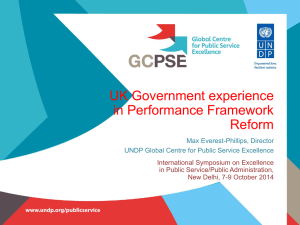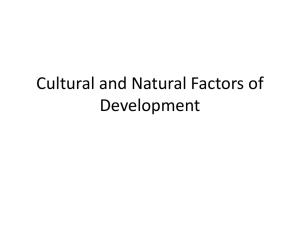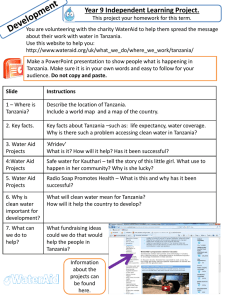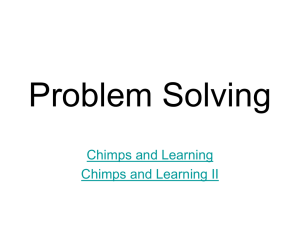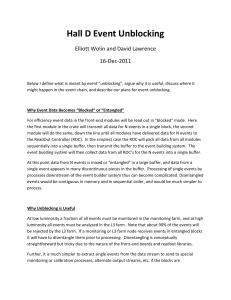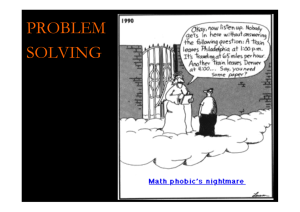Presentation - Devpolicy Blog from the Development Policy Centre
advertisement
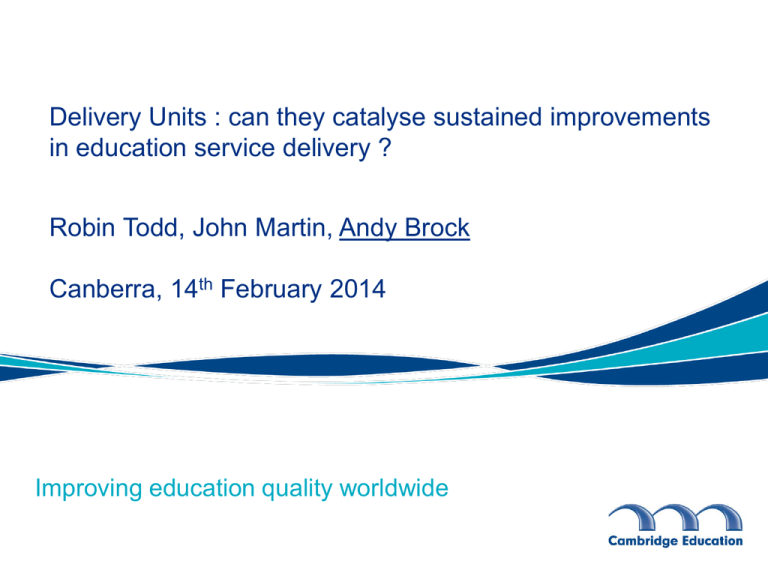
Delivery Units : can they catalyse sustained improvements in education service delivery ? Robin Todd, John Martin, Andy Brock Canberra, 14th February 2014 Improving education quality worldwide The Context - Common Public Service Delivery Challenges • Lack of clarity as to the practical steps needed to turn national policy commitments into tangible outcomes. • Lack of joined up working at national level - policy priorities falling across or between Ministries with unclear accountability for results. • National level challenge to ensure quality of delivery when responsibility is devolved to local level. If results are poor in one local area it is still the national government which gets the blame for this! • Focus on process and procedures rather than outcomes - little sense of urgency to make a positive difference. • Lack of local level understanding of national commitments means that intended results are never realised. Shang mian you zheng ce, xia mian you dui ce One answer ? – Delivery Units • Why ? • To drive performance improvements in critical service delivery areas • To inject urgency into dealing with delivery challenges Defining Characteristics of Delivery Units • Must be accompanied by real willingness from the very top of government to change behaviour and improve outcomes. • Receives authority directly from the top • Sits outside government structures • PMDU under Blair 2001 ; <40 ; cross-government ; narrow focus • Later replicated / adapted in USA, Australia, Malaysia, Tanzania etc. Defining Characteristics of Delivery Units • Focus relentlessly on performance • Data analysis and presentation essential • Linking the leadership to delivery on the ground Performance policy Performance monitoring Capacity building • Unblocking delivery obstacles • Building relationships and capacity Unblockin g delivery obstacles Delivery Units in developing countries Case 1 - Pakistan • Punjab province – Chief Minister of Punjab Shahbaz Sharif is key driver. Support is from Professor M Barber and team personally “This time it’s going to be different” • Separate team established under Barber. Recruited 900 District Monitoring Officers (ex-army) to visit all 60,000 schools every month • Monthly meetings with Chief Minister – personalised. Quarterly stocktakes – detailed analysis • Achievements according to Barber : – Enrolment : “Extra 1.5m children (aged 5-16) in school” – Attendance : 82% baseline (8/2011) had risen to 92% (12/2012) – Teacher presence : 80% baseline (8/2011) had risen to 91% (12/2012) • “Irreversibility not sustainability” – example of Madhya Pradesh 2006-2008 change of Chief Minister Pakistan – the verdict ? • Positives – Political engagement : things are happening ; aligns with power structure – Focus on tangible issues and results • Negatives – World Bank (Das) has questioned scope of some of the achievements – would they have happened anyway – Heavily dependent on key individuals and their political capital – Heavily dependent on parallel structures • Uncertain – Costly ? Costly not to ? – How deep are the changes - more than cosmetic ? Case 2 - Tanzania • Called Big Results Now ! Covering 6 sectors : Education, Energy, Agriculture, Water, Transport and Resource Mobilisation • Strongly influenced by Malaysia – support provided by Malaysia • In education focus is on improving quality of primary and secondary education through nine activity strands and 3 targets known as National Key Results Area : • – To create transparency on 3R skills levels in standard II – To achieve 80%+ pass rate in Primary PSLE exams – To achieve 80%+ pass rates in Secondary CSEE Exams Education MDU responsible for driving, reporting and supporting – performance monitoring phase Tanzania – Progress ? • Too early to see results (only launched in August 2013) but some issues arising include : – Quality and flow of data – without this performance management difficult – Are there too many activities, creating less focus and dissipated energy ? – Is the reporting culture ready for this ? • The Malaysian connection – looking in the right direction ? • Nonetheless : – A window of change has opened (though for how long ? – High levels of awareness – a debate about change – MDU mix of staff is promising – Public officials focusing on outcomes and performance rather than process and protocols Delivery Units - can they deliver sustained improvements ? • Catalysing opportunity for changing culture – but what conditions will make it sustainable ? Irreversible ? • Does it depend on the right people at the right time ? Can it be systematised? • Is the narrow focus – just a few key indicators – enough to sustain change ? • Data quality, timeliness, analytical capacity – big assumptions • Perhaps better for technically simple issues ? • Can DU’s shift systems ? Can they shift as well from poor to adequate as from adequate to excellent ? Sustained improvements ? Figure 1: Outputs and Outcomes classified by Technical Complexity and Political Difficulty THANK YOU Andy.Brock@camb-ed.com Initial DU work Mature phase DU work Performance policy Performance monitoring Capacity building Unblocking delivery obstacles Capacity building Unblocking delivery obstacles Performance policy Performance monitoring


